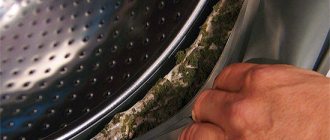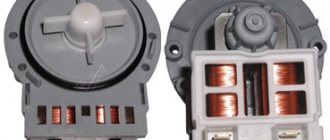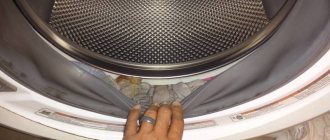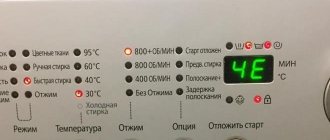Washing machine smell is a fairly common problem. Water constantly passes through the unit, some of it remains inside the tank, in tubes and hoses. Humidity and heat are favorable conditions for the growth of bacteria and fungus, and with them an unpleasant odor appears.
An unpleasant odor can appear in any washing machine, even a recently purchased one.
How to remove odor from an automatic washing machine and prevent its reappearance? In our article we will give answers to these questions. Let's start by looking at the causes and sources of the appearance of a repulsive odor.
What exactly can a washing machine smell like?
The most disgusting smell that can come from a machine is the smell of fungal mold. It is so sharply sweet and smells simply disgusting. It's downright heartbreaking. And it’s absolutely impossible to wear something that smells like that.
Also, the machine may smell of acetone, gasoline or other chemicals. But in this case, everything is not so scary, since the culprit is some dirty thing in gasoline that you threw into the washing machine. And such a smell washes out on its own. A couple of washes with some old sheet and that’s it, the problem is solved.
So, there is no point in talking about this; it’s better to discuss how to detect and neutralize the moldy smell. This is really a problem that can lead to not only unnecessary expenses, but also endless fuss.
Drying
The drying mode is not available in all models . This is an additional option that allows you to process things by drying them. After such exposure, the laundry comes out of the machine almost dry.
In machines without drying, things remain damp even with very intense spinning. The presence of a drying mode in the device significantly increases the cost of the washing machine.
Read this article for tips on how to dry your laundry.
Places where fungus accumulates or why there is a smell in the washing machine
There are a lot of places like this, and it’s scary... It’s unlikely that anyone, the first time, was able to correctly determine where exactly the stink was coming from.
Sources of unpleasant odor in the washing machine can be:
- The drum itself, just not inside where you can see it, but from behind;
- Channel through which detergents are supplied;
- Tray (cuvette) for powders;
- Heating heating element (especially if it has begun to oxidize);
- Drain hose or filter;
- Stagnation of water in the lower part of the machine due to improper installation/setting;
- General communications pipes (only in old houses).
As you can see, there are plenty of places that are not so easy to clean. But the worst thing is the last option. Below we will describe step by step how to deal with the smell in each specific case. In the meantime, read the hint to our long article.
Chlorine-containing products
Chlorine will help remove odors from your washing machine. Using chlorine-containing compounds is very convenient to get rid of unpleasant odors. At the same time, they additionally disinfect. You can take any chlorine-based product. An example is whiteness. You should take 100 g and pour it into the compartment intended for powder. After this, the boiling program starts. An additional rinse is required. The drum and cuff are wiped after use so that the chlorine does not “eat” the rubber. The door is not closed. It is necessary to ventilate the room well after cleaning. You can also wash your washing machine to remove the rotten smell.
Is there one universal way to get rid of odor?
Many people think that it is not at all necessary to look for something there and clean it, you can just take and run the machine using some kind of chemical. After all, in theory, it should get into all the places and crevices and automatically wash out the suspected areas where fungus accumulates.
In principle, this is the right decision and you should always start with it. But, keep in mind that washing must be done not just once, but a couple of times in a row.
Why is that? But because an acid or other chemical substance may not completely break down the plaque the first time, but only “fluff” it, which will only intensify the stench. Therefore, rinse twice and if this does not help, then you will have to look for the root of the evil...
What and how can you wash a washing machine?
Firstly:
“Idle” washing should be done only with hot water, in boiling mode.
This is the most important point. The second is the choice of means. It is not necessary to take expensive chemicals; if you wish, you can get by with folk remedies.
Calgon is a good thing, but it should be used in extreme cases. It removes scale, but it ruins the rubber. Cars break down very quickly if you get carried away with this product. You can only apply it once a year or if there is an odor.
Citric acid is no worse than Calgon, if not better. It perfectly dissolves scale and sediment and at the same time does not “kill” rubber. She can and should wash the machine “idle”, about once every two months. Just pour a pack of lemon juice into the drum and set the wash to boiling. This method helps to quickly get rid of problems.
Soda (we do not recommend) is a weaker remedy and can be used if there is absolutely nothing at hand and nothing is foreseen. But, frankly speaking, it is difficult to imagine such a situation in our 21st century.
Vinegar (we don’t recommend it) is an acid and, theoretically, it should clean no worse than lemon juice. But in reality, vinegar is no match for powdered citric acid concentrate. Not only is it not able to properly remove scale, but it also leaves behind such a smell that you will wash for a week and your clothes will smell like vinegar.
Bleach (we do not recommend) - it dissolves very well. The fungus is completely powerless against it. But then cleaning the car from the smell of bleach will not be so easy. You will need to run it three times, with clean water without additives, and then ventilate the machine for a long time. And most importantly, running with bleach is not a guarantee that the smell will definitely go away, since it may be in a place where the solution simply cannot reach.
So, what is the conclusion: it is best to start any cleaning with a run with lemon juice, since it dissolves well and there is no need to ventilate afterwards.
Step-by-step ways to neutralize odor
Experimenting with powders and conditioners
Very often it is detergents that cause the smell. Cheap powders do not dissolve completely, therefore, after washing, the machine parts remain not clean, but stuck with microparticles of these miracle powders.
And, if you wash often, then there will be no problems. And, if once a week or less, then during this time mold has time to develop. Moreover, on any parts, even on those that cannot be “reached” by a run with citric acid.
Removing odor from the drum
Here we are not talking about whether the drum is dirty on the inside. The drum may be covered with mold from the outside, which means that only a workshop, a complete disassembly of the machine and significant expenses will save you.
There's a lot of dirt there, believe me. If you regularly do preventive maintenance, which you will read about below, then such a moment will come much later, but it will still come.
Removing odor from the powder tray
If you have a top-loading machine, then everything is simple. Take out the drawer and wash it thoroughly with an old toothbrush. If we are talking about a horizontal machine, where there is almost no access to the ditch, then you will have to dodge and clean the compartment with improvised means.
For example, you can wrap cotton wool around a thin, long knitting needle, soak it in alcohol or bleach and wipe it. You can simply pour bleach into it, but do not forget to then idle the car several times.
Cleaning the detergent supply channel
If it is clogged, then a knitting needle with cotton wool will help here too. But, in theory, it should be cleaned at the moment when you start a single wash with lemon.
And, frankly, this is not the place that is the source of the damage and where the smell might come from. But, careless owners can do anything, so we are listing this place just in case.
Cleaning the drain filter
In principle, there is almost no smell of fungus from the filter. Rather, it may smell, so to speak, not of fungus at all, but of garbage, since pieces of food may get in there. But, in any case, you need to take out this filter, check it and wash it thoroughly if necessary.
Removing scale from the heating element
The heating element, too, is unlikely to become covered with fungus. It becomes overgrown with a “fur coat” of scale. It, of course, can give off some very faint odor, but it has nothing to do with the smell of mold.
So, be that as it may, since you’ve already gotten there and “gutted” the machine, it’s worth paying attention to the heating element and cleaning it. You can remove it and soak it for a day or three in a strong lemon solution, this helps.
But, in general, heating elements need to be cleaned not only for the sake of cleanliness, but for the sake of saving energy.
The more coating the heating element is, the more current it draws to give the temperature required for washing. That is, it needs more power and time to heat the water. And such a load affects the motor... Everything in the machine is interconnected, just like in the human body.
Changing or cleaning the drain hose
Everything is simple here. Unplug it and smell it. If there is a smell, try soaking it in a bleach solution for a day. If this doesn’t help, then buy a new one and don’t fool yourself. It's not that much money.
Looking for stagnant water
It happens that the smell comes from the container below, where there is always some water left. In general, this is some kind of strange and exceptional case, since, in theory, there should always be water there to protect the rubber from drying out.
But, if you installed the machine incorrectly, at the wrong level, then there may be a misalignment and there will be much more water there than necessary. In general, we can’t say exactly why this happens, but in that exact place there definitely shouldn’t be a smell. Maybe you were away for a couple of months? Then maybe there was some kind of stagnation. And even then, this cannot be.
We are fighting with the housing office and demanding replacement of pipes
If your laundry starts to smell unpleasant, then don’t rush into fanfare and check if there is a smell from another tap that comes from the same pipe? Sometimes it is completely unnoticeable, for example, in the same bathroom.
Let’s say the first portion of water has some kind of smell, and then it is drained and, in the end, you simply don’t notice that there is a smell. The first batch of stagnant water from the pipes is drawn into the machine and it runs there throughout the entire cycle.
In general, if the problem is in the pipes, then the problem is the pipe. We will have to raise all the neighbors to their feet, collect signatures and go to the utility services, demanding that the pipes be repaired. This is a troublesome and slow task.
In our country, even in case of accidents, when the basement is completely flooded with sewage water, they don’t fuss too much, and in this case, even more so... But no one is stopping you from being persistent. What should we do if in our country they won’t move without a kick?
How to prevent the appearance of a stale smell?
It is always better to do prevention than to urgently get rid of the consequences. So, what should you not do and what can you do to prevent mildew in your washing machine?
1. Do not store dirty laundry directly in the drum. When you put it in it is not always perfectly dry and it may well begin to “rot.” And after such a wash, the machine may smell two or three more times, and you will think that the problem is in some spare parts.
By the way, the fungus “blooms” most quickly on fabrics that were previously washed with a large amount of conditioner, and it was not completely rinsed.
2. Don't overdo it with conditioners. This is exactly the case when porridge with butter will ruin it. Try to purchase more or less high-quality chemicals that can be rinsed out in one wash.
3. Always leave the machine open after washing. Of course, everyone knows this, but for some reason not everyone does it. The moisture remaining on the walls of the washing machine after washing is quite enough to “proliferate” the fungus in just a week, but it will be difficult to remove the smell.
4. No need to pour powder into the tray! Pour it directly into the drum. The powder is never completely washed out of the cuvettes, especially when it comes to washing in cold water. And, if it’s easy to wash a tray in a machine with a vertical loading, then the ditch of a horizontal machine is practically inaccessible. If the powder compartment is empty, then no fungus will grow there. And if there are wet lumps of powder there all the time, then you understand that they will become covered with black spots.
5. Try to rarely use the cold water wash cycle. This is not such a saving, believe me. But your things are not washed from excess powder, and the machine parts themselves are not washed during the washing process, which means fungus is not far off. And the fungus, not only does it smell disgusting, it also kills you. However, the remaining powder that you breathe in every day also kills in the same way.
Baking soda
Another option to remove unpleasant odors from your washing machine is baking soda. This will get rid of mold inside the unit. You will also be able to forget about fungal plaque. You don't have to think about why your washing machine smells bad. You just need to take a glass of water and a glass of soda. The solution is applied to all affected parts. Another glass of sodium bicarbonate is poured instead of powder. After this, boiling is started, as well as additional rinsing. Copper sulfate can be a substitute for meat. To do this, take a liter of water and dilute 30 g of vitriol in it. Available parts are processed, and the remainder is poured into the drum. After this, the wash is started, at which the water heats up to 90 degrees.











